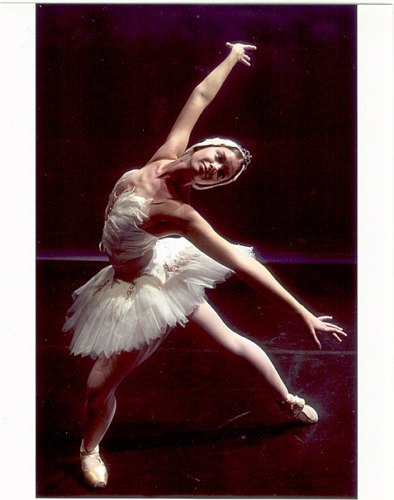Highland Highlights by Loraine Ritchey
MOM, The Common Denominator

Janet in Swan Lake photo campbell
I started this article as a comparison between the Highland mum who spends time, effort, money and sacrifices for their dancer’s sake when the only avenue to achieve notoriety or fame is through the competitive venue and the mum of a ballerina whose child is living her professional performance dream My initial wording as to the lack of a “professional “ dance company as related to Highland sent me checking just to make sure I was being accurate.
Surfing the websites of Scottish Dance and Highland in particular I came across the “Scottish Dance Company of Canada", which billed itself as “The Scottish Dance Company of Canada is a professional highland dance company which was established in 1996 and is based in Toronto, Ontario” and the Scottish Step Dance Company, Scotland as well as Mats Melin’s “Dannsa” Company. I hadn’t thought of these dance companies in the same way I thought of New York City Ballet or the Royal Ballet.
So came the quest to define “professional company”, which I found to my chagrin was no easy task.I contacted Actors Equity USA, Canada Equity and Equity UK. I searched archives, contacted those in the print media who reviewed dance and theatre as to the yardstick used, the performers, dancers, teacher and dance companies, although I feel I am in danger of plunging headlong into a minefield, this is what I found was the common denominator by those I contacted.
The "company" has a set performance schedule annually, dancers are auditioned for places in the company, the performers were under contract to the company including those that were paid by performance, the performers were considered “professional” (dance being the way they earn their living, not to say they don’t supplement their wages with part time jobs out of dance such as waiting tables etc. but dance is their “occupation”).Their peers consider the company professional.
Having an equity card may help define a professional status for some but on the whole dancers as one source stated “most ballet companies are non-union.However, there are some unionized professional companies but the union is more for the company (needs to abide by certain rules Concerning rehearsals, salary, etc.) than for the dancers.Dancers are not unionized .If they work for a union company, however, they are often paid more and get more benefits. Dancers can move from unionized company to non-union with no problem, since dancer themselves are not union members”. In other words the participants in the company are the main employer and the dancers are the employees and all that entails. Some dancers in top professional companies can indeed earn a good living wage, principles in a successful company and top choreographers do extremely well.
Did the Scottish Dance companies mentioned meet the definition? Even though the Scottish Dance Company of Canada for instance has SOBHD World Champions in performance, none of those dancers earn their primary wage from Scottish Dance, from their website I saw no defined season, it was more “ performance upon demand”.The request for clarification as to their “professional” status and more information was not answered by the SDCC. However, Canada Equity did state, “The Scottish Dance Company of Canada is not an engager with whom Equity has a contractual relationship “. The same with the Scottish Step Dance Company although apparently some of their dancers may be considered professional as they earn their living as dancers.
Unfortunately, it seems from my research, for the dancers of Highland the competitive venue and in the case of the SOBHD Highland Dancer the pinnacle of success is the Cowal SOBHD World Championship. There are performance opportunities with some of the large pipe bands and their concerts or dancing with top Scottish Musicians but as far as turning professional as a Highland Dancer not yet, they still have to keep the “day “ job. One or two dancers have pushed the envelope in this area Laura Caruthers who has been mentioned in this column more than once. World Highland Dance Champions (prior to SOBHD exclusivity of Cowal) Champions such as Victor Wesley and Hugh Bigney both went on to very successful “professional dance “ careers (non Highland) and in 1999 Michigan’s Ashley Knox won the SOBHD Juvenile World Championship at Cowal. Ashley now dances in the corps de ballet for the Miami City Ballet Company.
What is it like to be the mum of a “professional “ dancer in the world of performance? Since very few actually have that experience and hardly any in Highland I turned to a friend Jeannette Strukely. Jeanette was the representative for Lorain County’s only professional dance company “Ohio Dance Theatre” as a founding member of the Lorain Arts Council. During our time together making masks and table decorations for fundraising events for the newly formed Arts Council, putting together programs and covering ourselves in glitter and glue the discussion inevitably turned to dance, my daughter the ex- highland dancer and her daughter the ballerina. I found that we had more in common than our love for the arts but we as dancing mums shared a common story, the sacrifice that mums make so that their “ dancer can dream”. To be continued...